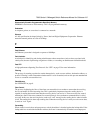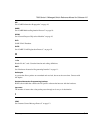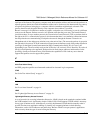
7000 Series L3 Managed Switch Reference Manual for Software v2.0
Glossary C-13
small part of the Internet. The gateway computer reads the destination address and forwards the packet to an
adjacent gateway that in turn reads the destination address and so forth across the Internet until one gateway
recognizes the packet as belonging to a computer within its immediate neighborhood or domain. That
gateway then forwards the packet directly to the computer whose address is specified.
Because a message is divided into a number of packets, each packet can, if necessary, be sent by a different
route across the Internet. Packets can arrive in a different order than they were sent. The Internet Protocol
just delivers them. It's up to another protocol, the Transmission Control Protocol (TCP) to put them back in
the right order. IP is a connectionless protocol, which means that there is no continuing connection between
the end points that are communicating. Each packet that travels through the Internet is treated as an
independent unit of data without any relation to any other unit of data. (The reason the packets do get put in
the right order is because of TCP, the connection-oriented protocol that keeps track of the packet sequence in
a message.) In the Open Systems Interconnection (OSI) communication model, IP is in Layer 3, the
Networking Layer. The most widely used version of IP today is IP version 4 (IPv4). However, IP version 6
(IPv6) is also beginning to be supported. IPv6 provides for much longer addresses and therefore for the
possibility of many more Internet users. IPv6 includes the capabilities of IPv4 and any server that can
support IPv6 packets can also support IPv4 packets.
J
Joint Test Action Group
An IEEE group that specifies test framework standards for electronic logic components.
JTAG
See “Joint Test Action Group” on page 13.
L
LAN
See “Local Area Network” on page 14.
LDAP
See “Lightweight Directory Access Protocol” on page 13.
Lightweight Directory Access Protocol
A set of protocols for accessing information directories. LDAP is based on the standards contained within
the X.500 standard, but is significantly simpler. Unlike X.500, LDAP supports TCP/IP, which is necessary
for any type of Internet access. Although not yet widely implemented, LDAP should eventually make it
possible for almost any application running on virtually any computer platform to obtain directory
information, such as e-mail addresses and public keys. Because LDAP is an open protocol, applications
need not worry about the type of server hosting the directory.


















